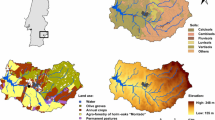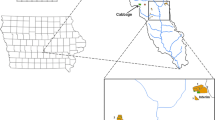Abstract
Dissolved organic carbon (DOC) concentrations and export were studied in two small catchments in central Ontario to examine DOC sources and to assess the hypothesis that organic matter adjacent to the stream is a significant contributor of DOC during storms. Different DOC dynamics and exports were observed according to the depth of the riparian water table. In Harp 4-21, riparian flowpaths were predominantly through A and upper B soil horizons and riparian soils contributed between 73 and 84% of the stream DOC export during an autumn storm. In Harp 3A, riparian flowpaths were predominantly through lower B horizons. Consequently, riparian soils were less important and hillslopes contributed more than 50% of the stream DOC export in subcatchments without wetlands during storms. Wetlands and adjacent soils contributed significantly to DOC export in Harp 3A; 8% of the total catchment area exported 32 to 46% of the storm runoff DOC. DOC export dynamics in wetlands and riparian soils were distinctly different. In wetlands, transport was affected by leaching and flushing of DOC at the wetland surface leading to lower DOC concentrations with successive storms. In riparian soils, groundwater flowpaths were more important and stronger positive relationships between discharge and DOC concentration were observed. Precipitation, throughfall and stemflow were minor sources of stream DOC during storms and contributed less than 20% of the total export.
Similar content being viewed by others
References
Aravena R, Schiff SL, Trumbore SE, Dillon PJ & Elgood R (1992) Evaluating dissolved inorganic carbon cycling in a forested lake watershed using carbon isotopes. Radiocarbon 34(3): 636–645
Boyer EW, Hornberger GM, Bencala KE & McKnight DM (1996) Overview of a simple model describing variation of dissolved organic carbon in an upland catchment. Ecol. Model. 86: 183–188
Brunke M & Gosner T (1997) The ecological significance of exchange processes between rivers and groundwater. Fresh. Biol. 37: 1–33
Dankevy SN (1989) Groundwater Flow and Chemistry in a Small Acid-Stressed Sub-Catchment of the Canadian Shield. Master's Project, University of Waterloo, Ontario (unpublished)
Devito KJ, Hill AR & Roulet N (1996) Groundwater-surface water interactions in headwater forested wetlands of the Canadian Shield. J. Hydrol. 181: 127–147
Dillon PJ & Molot LA (1997) Dissolved organic and inorganic carbon mass balances in central Ontario lakes. Biogeochem. 36: 29–42
Dosskey MG & Bertsch PM (1994) Forest sources and pathways of organic matter transport to a blackwater stream: a hydrological approach. Biogeochem. 24: 1–19
Easthouse KB, Mulder J, Christophersen N & Seip HM (1992) Dissolved organic carbon fractions in soil and stream water during variable hydrological conditions at Birkenes, South Norway. Water Resour. Res. 28(6): 1585–1596
Eckhardt BW & Moore TR (1990) Controls on dissolved organic carbon concentrations in streams, southern Quebec. Can. J. Fish. Aqu. Sci. 47: 1537–1544
Fiebig DM, Lock MA & Neal C (1990) Soil water in the riparian zone as a source of carbon for a headwater stream. J. Hydrol. 116: 217–237
Fiebig DM (1995) Groundwater discharge and its contribution of dissolved organic carbon to an upland stream. Arch. Hydrobiol. 134: 129–155
Ford TE & Naiman RJ (1989) Groundwater-surface water relationships in boreal forest watersheds: Dissolved organic carbon and inorganic nutrient dynamics. Can. J. Fish. Aqu. Sci. 46: 41–49
Freeze RA (1974) Streamflow generation. Rev. Geophys. 12(4): 627–647
Grieve IC (1984) Concentrations and annual loading of dissolved organic matter in a small moorland stream. Fresh. Biol. 14: 533–537
Helvey JD & Patric JH (1965) Canopy and litter interception of rainfall by hardwoods of eastern United States. Water Resour. Res. 1(2): 193–206
Hemond HF (1990) Wetlands as the source of dissolved organic carbon to surface waters. In: Perdue EM & Gjessing ET (Eds) Organic Acids in Aquatic Ecosystems (pp 301–313). John Wiley & Sons, New York
Hinton MJ, Schiff SL & English MC (1993) Physical properties governing groundwater flow in a glacial till catchment. J. Hydrol. 142: 229–249
Hinton MJ, Schiff SL & English MC (1994) Examining the contributions of glacial till water to storm runoff using two-and three-component hydrograph separations. Water Resour. Res. 30(4): 983–993
Hinton MJ, Schiff SL & English MC (1997) The significance of runoff events on the concentrations and export of dissolved organic carbon from two Precambrian Shield watersheds. Biogeochem. 36: 67–88
Jardine PM, Wilson GV, McCarthy JF, Luxmoore RJ, Taylor DL & Zelazny LW (1990) Hydrogeochemical processes controlling the transport of dissolved organic carbon through a forested catchment. J. Contam. Hydrol. 6: 3–19
Jeffries DS & Snyder WR. (1983) Geology and Geochemistry of the Muskoka-Haliburton Study Area. Data Report DR 83/2, Dorset Research Centre, Dorset, Ontario
Kaplan LA & Newbold JD (1993) Biogeochemistry of dissolved organic carbon entering streams. In: Ford TE (Ed) Aquatic Microbiology: An Ecological Approach (pp 139–165). Blackwell Scientific Publications, Oxford
LaZerte BD & Scott L (1996) Soil water leachate from two forested catchments on the Precambrian Shield, Ontario. Can. J. For. Res. 26: 1353–1365
Lozano FC, Parton WJ, Lau JKH & Vanderstar L. (1987). Physical and Chemical Properties of the Soils at the Southern Biogeochemical Study Site. MOE BGC Rep. Ser., BGC-018, Faculty of Forestry, University of Toronto, Ontario
MacLean RA (1992). The Role of the Vadose Zone in the Generation of Runoff from a Headwater Basin in the Canadian Shield. M.A. thesis, Dept. Geog., Wilfrid Laurier University
MacLean RA, English MC & Schiff SL (1995) Hydrological and hydrochemical response of a small Canadian Shield catchment to late winter rain-on-snow events. Hydrol. Proces. 9: 845–863
Mann CJ & Wetzel RG (1995) Dissolved organic carbon and its utilization in a riverine wetland ecosystem. Biogeochem. 31: 99–120
McDowell WH & Likens GE (1988) Origin, composition, and flux of dissolved organic carbon in the Hubbard Brook Valley. Ecol. Mon. 58(3): 177–195
Meyer JL (1990) Production and utilization of dissolved organic carbon in riverine ecosystems. In: Perdue EM & Gjessing ET (Eds) Organic Acids in Aquatic Ecosystems (pp 281–299). John Wiley & Sons, New York
Molot LA & Dillon PJ (1996) Storage of terrestrial carbon in boreal lake sediments and evasion to the atmosphere. Global Biogeochem. Cycles 10: 483–492
Moore TR (1989) Dynamics of dissolved organic carbon in forested and disturbed catchments, Westland, New Zealand. 1. Maimai. Water Resour. Res. 25: 1321–1330
Nelson PN, Baldock JA & Oades JM (1993) Concentrations and composition of dissolved organic carbon in streams in relation to catchment soil properties. Biogeochem. 19: 27–50
Ontario Ministry of the Environment (MOE) (1983) Handbook of Analytical Methods for Environmental Samples. Lab. Serv. Branch, Rexdale, Ontario
Rutherford JE & Hynes HBN (1987) Dissolved organic carbon in streams and groundwater. Hydrobiol. 154: 33–48
Schiff SL, Aravena R, Trumbore SE & Dillon PJ (1990) Dissolved organic carbon cycling in forested watersheds: a carbon cycle approach. Water Resour. Res. 26: 2949–2957
Schiff SL, Aravena R, Trumbore SE, Hinton MJ, Elgood R & Dillon PJ (1997) Export of DOC from forested catchments on the Precambrian Shield of Central Ontario: Clues from 13C and 14C. Biogeochem. 36: 43–65
Trumbore SE, Schiff SL, Aravena R & Elgood R (1992) Sources and transformation of dissolved organic carbon in the Harp Lake forested catchment: The role of soils. Radiocarbon 34: 626–635
Ward RC (1984) On the response to precipitation of headwater streams in humid areas. J. Hydrol. 74: 171–189
Wood EF, Sivapalan M & Beven K (1990) Similarity and scale in catchment storm response. Rev. Geophys. 28: 1–18
Author information
Authors and Affiliations
Rights and permissions
About this article
Cite this article
Hinton, M., Schiff, S. & English, M. Sources and flowpaths of dissolved organic carbon during storms in two forested watersheds of the Precambrian Shield. Biogeochemistry 41, 175–197 (1998). https://doi.org/10.1023/A:1005903428956
Issue Date:
DOI: https://doi.org/10.1023/A:1005903428956




